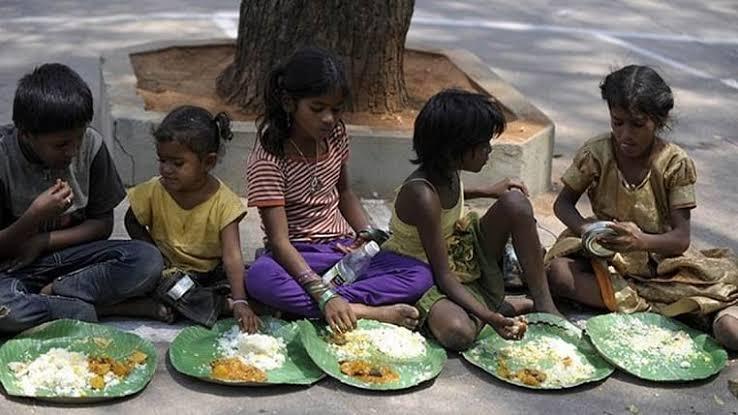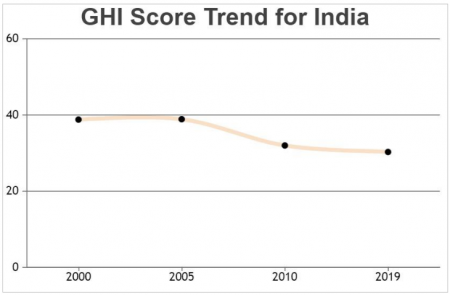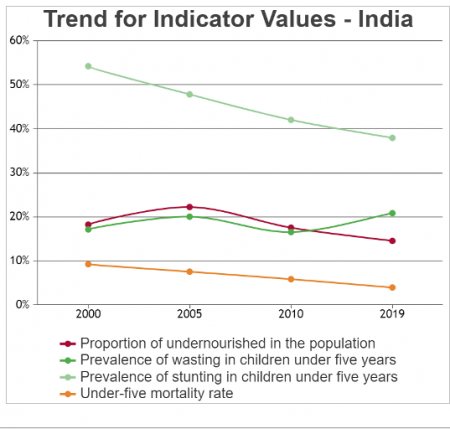India Ranks 102 on Global Hunger Index 2019, Scores Lower Than All Neighbours

Image Courtesy: Free Press Journal
India has slipped to rank 102 out of 117 countries analysed in the Global Hunger Index (GHI) 2019. The country has slipped behind the neighbouring countries of Sri Lanka, Nepal, Pakistan, Bangladesh, and Myanmar. The countries with GHI scores of less than 5 shared the top rank on the Index. These included Belarus, Bosnia & Herzegovina, Bulgaria, Chile, Costa Rica, Croatia, Cuba, and Estonia. India scored 30.3 on the Index that was released on Tuesday, October 15, by Irish aid agency Concern Worldwide and German organisation, Welt Hunger Hilfe.
The GHI score is calculated on four indicators – undernourishment, child wasting, child stunting, and child mortality. India has slipped from the rank of 80 among 104 countries in 2015 to the current rank of 102 among 117 countries. The country’s score has also seen a slight increase from 29 in 2015 to 30.3 in 2019. According to the report, India’s GHI indicator values have an outsized impact on the indicator values for the region because of its large population.

At 20.8%, India also has the highest child wasting rate among the countries ranked in the GHI. The report said that South Asia’s child wasting rate constitutes a critical public health emergency, and this is all the more concerning because instead of decreasing, the rate has slightly increased since 2000. It added, “The child wasting rate for the region is amplified in part by that of India, which has the region’s largest population and highest level of child wasting.”
It was pointed out in the report that a study of six South Asian countries found that a lower maternal body mass index was significantly associated with child wasting in five of the six countries. Inadequate access to improved water sources and low family wealth were also associated with child wasting in some countries, but not systematically so. It said, “Because a reduction in poverty does not necessarily imply adequate access to improved water sources and sanitation, poverty alleviation policies may not be sufficient to reduce child wasting.”
Also read: Only 6.4% of Indian Children Get Minimum Adequate Diet, Says Study
According to the GHI, India’s child stunting rate, 37.9%, is also categorised as very high in terms of its public health significance. It pointed out that only 9.6% of all children between 6 and 23 months of age are fed a minimum acceptable diet. This number is even lower according to the Comprehensive National Nutrition Survey (CNNS) released by the Ministry of Health and Family Welfare on October 7, which said that only 6.4% of the children in that age bracket receive minimum adequate diet.

The report added, “As of 2015–2016, 90% of Indian households used an improved drinking water source while 39% of households had no sanitation facilities. In 2014, the prime minister instituted the “Clean India” campaign to end open defecation and ensure that all households had latrines. Even with new latrine construction, however, open defecation is still practiced. This situation jeopardises the population’s health and consequently children’s growth and development as their ability to absorb nutrients is compromised.” Prime Minister Narendra Modi had on October 2 announced that all the villages in India have declared themselves to be open defecation free.
India had the third lowest GHI score among the countries in South, East, and Southeast Asia, ranking slightly above Timor-Leste and Afghanistan. It’s neighbouring countries, Sri Lanka (17.1), Myanmar (19.8), Nepal (20.8), Bangladesh (25.8), Pakistan (25.8) all ranked higher than India on the Index. Ranking 66 and 69 respectively, Sri Lanka and Myanmar were categorised as countries with moderate level of hunger, while Nepal (73), Bangladesh (88), Pakistan (94), and India (102) were categorised as countries with serious hunger issues.
Also read: India Has Failed Its Children, Tops in Stunting and Wasting
Get the latest reports & analysis with people's perspective on Protests, movements & deep analytical videos, discussions of the current affairs in your Telegram app. Subscribe to NewsClick's Telegram channel & get Real-Time updates on stories, as they get published on our website.
























